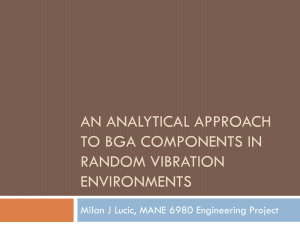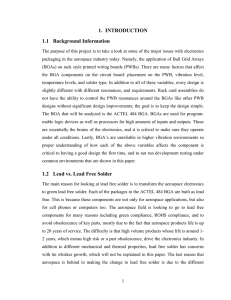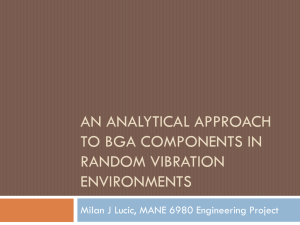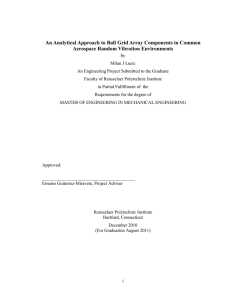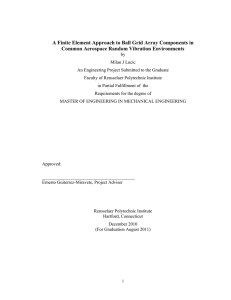An Analytical Approach to Ball Grid Array Components in Common
advertisement
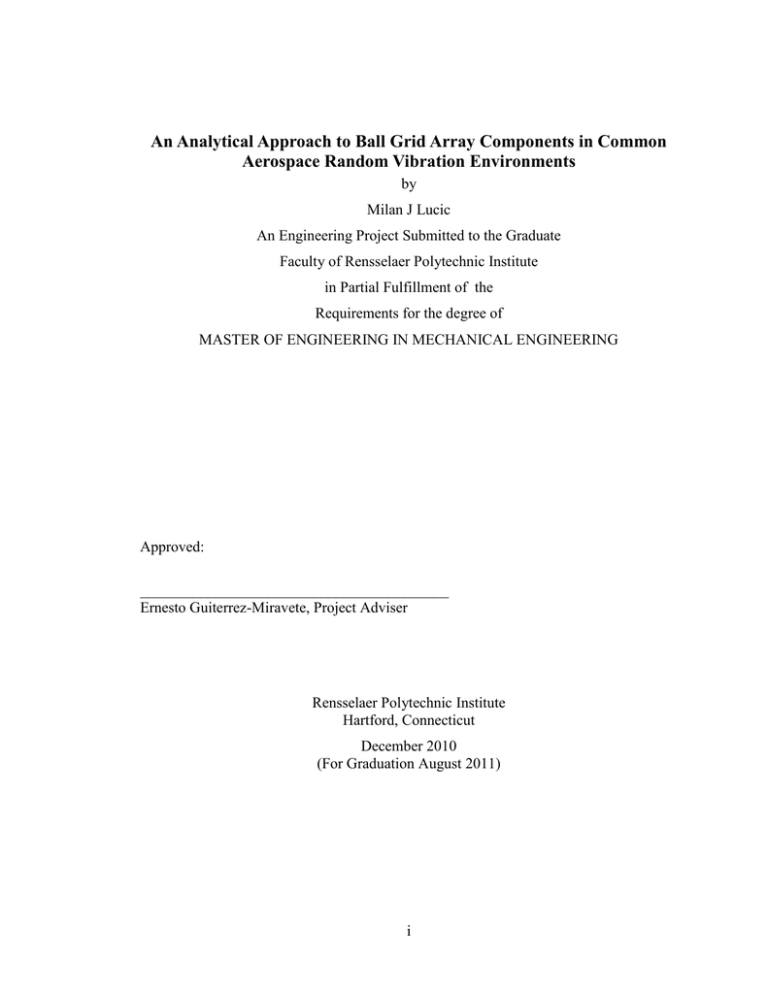
An Analytical Approach to Ball Grid Array Components in Common Aerospace Random Vibration Environments by Milan J Lucic An Engineering Project Submitted to the Graduate Faculty of Rensselaer Polytechnic Institute in Partial Fulfillment of the Requirements for the degree of MASTER OF ENGINEERING IN MECHANICAL ENGINEERING Approved: _________________________________________ Ernesto Guiterrez-Miravete, Project Adviser Rensselaer Polytechnic Institute Hartford, Connecticut December 2010 (For Graduation August 2011) i © Copyright 2010 by Milan J Lucic All Rights Reserved ii CONTENTS An Analytical Approach to Ball Grid Array Components in Common Aerospace Random Vibration Environments ................................................................................. i LIST OF TABLES ............................................................................................................ iv LIST OF FIGURES ........................................................................................................... v NOMENCLATUREACKNOWLEDGMENT ................................................................. vi ACKNOWLEDGMENT ................................................................................................. vii ABSTRACT ................................................................................................................... viii INTRODUCTION ............................................................................................................. 1 1.1 Background Information .................................................................................... 1 1.2 Lead vs. Lead Free Solder .................................................................................. 1 1.3 Random Vibration for Fixed Wing Aircraft....................................................... 2 2. THEORY AND METHODOLOGY ........................................................................... 3 2.1 Analytical Model: PCB Normal Modes and Displacement ............................... 3 2.2 Finite Element Model: Random Vibration ......................................................... 5 2.3 FEA Model Optimization................................................................................... 9 3. RESULTS AND DISCUSSION ................................................................................ 10 3.1 Analytical Results ............................................................................................ 10 3.2 FEA Model Optimization................................................................................. 10 3.3 Finite Element Model ....................................................................................... 10 3.4 Miner's Damage Index Calculations ................................................................ 10 3.5 Fatigue Life ...................................................................................................... 10 4. CONCLUSIONS ....................................................................................................... 11 4.1 Future Work and Model Improvement ............................................................ 11 Literature Cited ................................................................................................................ 12 iii LIST OF TABLES iv LIST OF FIGURES Figure 2.1-1: PWB BGA Placement Figure 2.1-2: PWB and Inteconnect Diagram Figure 2-1-3: Gaussian Distribution for Stienberg 3 Band Method Figure 2.2-1: RTCA DO-160 Vibration Levels for Fixed Wing Aircraft Figure 2.2-2: Wedge Lock Card Guides v NOMENCLATURE vi ACKNOWLEDGMENT Type the text of your acknowledgment here. vii ABSTRACT There are many analyses about electrical components concerning mechanical stresses in electronics packaging for the aerospace industry. This approach is to investigate common aerospace random vibration environments for Ball Grid Array (BGA) components, specifically the 484-ball package. The Analysis includes looking at lead vs. lead free solder packages, different vibration environments, and circuit card assembly (CCA) placement. The result is not to find whether lead is better than lead free solder or what placement is best for BGA components, but what combination of the two works best in common vibration environments. The results will only take into account mechanical stresses of each ball and the entire package to determine the optimized placement and solder viii type. 1. INTRODUCTION 1.1 Background Information The purpose of this project is to take a look at some of the major issues with electronics packaging in the aerospace industry today. Namely, the application of Ball Grid Arrays (BGAs) on rack style printed wiring boards (PWBs). There are many factors that affect the BGA components on the circuit board: placement on the PWB, vibration level, temperature levels, and solder type. In addition to all of these variables, every design is slightly different with different resonances, and requirements. Rack card assemblies do not have the ability to control the PWB resonances around the BGAs like other PWB designs without significant design improvements; the goal is to keep the design simple. The BGA that will be analyzed is the ACTEL 484 BGA. BGAs are used for programmable logic devices as well as processors for high amounts of inputs and outputs. These are essentially the brains of the electronics, and it is critical to make sure they operate under all conditions. Lastly, BGA’s are unreliable in higher vibration environments so proper understanding of how each of the above variables affects the component is critical to having a good design the first time, and to not run development testing under common environments that are shown in this paper. 1.2 Lead vs. Lead Free Solder The main reason for looking at lead free solder is to transform the aerospace electronics to green lead free solder. Each of the packages in the ACTEL 484 BGA are built as lead free. This is because these components are not only for aerospace applications, but also for cell phones or computers too. The aerospace field is looking to go to lead free components for many reasons including green compliance, ROHS compliance, and to avoid obsolescence of key parts, mostly due to the fact that aerospace products life is up to 20 years of service. The difficulty is that high volume products whose life is around 12 years, which means high risk or a part obsolescence, drive the electronics industry. In addition to different mechanical and thermal properties, lead free solder has concerns with tin whisker growth, which will not be explained in this paper. The last reason that aerospace is behind in making the change to lead free solder is due to the different 1 techniques and procedures to assemble these parts to the PWBs. Lead based solder will not be around forever, hence the importance of studying the differences of lead vs. lead free solders and their mechanical responses in BGAs. 1.3 Random Vibration for Fixed Wing Aircraft Electronic controllers are not structural members of the aircraft and thus cannot be analyzed by simple static analysis. The mechanical stress analysis is governed by the requirements from RTCA-DO-160, which is an aerospace standard for environmental tests. Obviously one cannot test the electronics under the actual loads of the aircraft because it would take years to find out a result. RTCA DO-160 accelerates the vibration environments to test each axis in 1-5 hours on average. The random analysis is used primarily to solve frequency responses and find resonances/mode shapes of the PWBs. Typically this analysis is matched with test data to calculate the number of cycles to failure. The analysis is intended to be detailed and show a correlation of failure cycles to vibration level, solder type and placement. More detail will be discussed in the theory and methodology and chapter. 2 2. THEORY AND METHODOLOGY 2.1 Analytical Model: PCB Normal Modes and Displacement The analysis will be done based on a 6”x9” Printed Circuit Board (PCB). Of course there are many sizes and configurations that can be used to optimize the board design, but boards of this size are common in the lower fuselage electronics bays of aircraft. Placements will include the center of the board, upper right corner, lower left corner and left center. This is shown by the figure below: Figure 2.1-1: PWB BGA Placement Each placement on the board will have different results based on the curvature of the board and the board displacement at that point. This means that every single solder ball will have a unique max stress based on the curvature and placement. This is one key item to find in the analysis. The first thing about doing a Finite Element Model, analytical calculations are invaluable to determining if the solution is correct. There are some simple equations from Steinberg’s Vibration Analysis for Electronic Equipment. The first equation is used to solve for the first mode natural frequency of a PWB that is fixed on 3 edges and has 1 free edge (fixed means that the edge is controlled in all 6 degrees of freedom). The FEM boundary conditions are modeled to be exactly like a circuit card in a chassis. The fixed positions are from the connectors at one end of the PWB that connect to the interconnect, and also the two card guides on the long edge of the PWB. 3 Interconnect Fixed Edge (6DOF) (Card Guide) b Connectors Fixed Edge (6DOF) Free Edge a a Fixed Edge (6DOF) (Card Guide) Figure 2.1-2: PWB and Inteconnect Diagram fn D .75 2 12 4 2 2 4 [3] a 3 a b b D E * h3 [3] 12 * (1 2 ) The first mode natural frequency is based upon the Young’s Modulous, thickness, poisson’s ration, which is the plate stiffness D, the density and the length and width; a and b respectively. The second equation is to solve for the displacement of the PWB based off the first mode natural frequency at the center of the board. : Z RMS G 2 9.81* G [3] fn2 * P * Q* f n [3] The displacement is really a dynamic single amplitude response based on the first mode natural frequency and G, or GRMS. GRMS is the response of the PWB based off the transmissibility, Q, first mode natural frequency, and the power spectral density value where the first mode is. The transmissibility is then calculated through the random 4 analysis. These results are then compared for accuracy based on the FEM. Although the displacement calculated is accurate, it does not give you the worst case. Steinberg uses a 3 band method approach to determine max displacements of the PWB which is used for the high cycle fatigue life. This is the point where maximum damage will occur in the electrical components. Although based on this statistical approach will only occur 4.33% of the time, it must be considered in the overall damage calculations. Figure 2-1-3: Gaussian Distribution for Stienberg 3 Band Method The basic idea is that when the number of cycles reaches the number of allowed or calculated cycles, the part will ideally fail. Traditionally, this calculation is used to ensure that this never happens for any electrical component; BGA’s do not always follow the same “simple calculations” and have relatively short cycle lives. There is a lot that can go wrong with a single BGA: improper installation, solder joint failures due to thermal or structural inputs, and for each of these failures, every solder ball can be slightly different. Controlling this environment is crucial as well as the processes involved in assembling the BGA’s to PWB’s. 2.2 Finite Element Model: Random Vibration The FEM will be created in PATRAN with MD enabled version 2010 and solved with MD NASTRAN 2008. The FEM is composed of a few different types of elements to try and decrease the model size. The PWB consists of 2-D Hex-8 shell elements, as well as the BGA body. The Solder balls in the BGA will be modeled with 3-d Hex-20 elements for detail and accuracy. All of the elements are tied together using a glue constraint for deformable bodies through PATRAN. The Glue constraint makes it much easier to 5 connect multiple bodies and greatly reduce the number of user input REB2 or REB3 Multi point constraints. The method that is used to solve the problem of ball grid arrays and common aerospace random vibration environments is composed of multiple independent steps. The first is to simply run a modal analysis of the PWB with no BGA attached. Having the BGA attached to the PWB will not affect the stiffness to a degree of concern and the model can now be much smaller. The modal analysis should line up with the calculated results; this is the success criterion for this step. The next step involves developing a model for random vibration cases. Again the simple PWB model used for the modal analysis is used to keep the model size down during dynamic analysis. The result that is desired here is to find the max displacement of the PWB and then compare this to the hand calculations, again which should line up for each vibration case. The difference here is that for each random vibration case, although the natural frequencies are going to be the same as long as the boundary conditions are the same, the transmissibility will not be. This is the term that is calculated from the room mean square (RMS) of the vibration response of the board. From the modal analysis, it is easy to narrow down the area where the Q will be the highest and thus the highest displacement. The hand calculations are modified and again compared with the FEM results to validate this step. In the idea of keeping the model as light as possible and the iterations as few as possible, it was not possible to run the full model with the BGA on the PWB. Instead, taking the results from the random acceleration analysis, determining the max displacement, it is just as easy to run a static inertial analysis on the full FEM. This dramatically reduces the computation time for the study at hand. Although this deviates slightly from the original plan of running dynamic simulation for each case, the results are very close to one another. This is a standard industry practice that is creative and very time forgiving. Now that the thought process is given for how the FEM will be solved, the boundary conditions must be analyzed. The most important boundary condition or load case is of course the random vibration environments that are analyzed. The figure below from RTCA DO-160F shows the vibration curves for fixed wing aircraft: 6 Figure 2.2-1: RTCA DO-160 Vibration Levels for Fixed Wing Aircraft [1] The PWB boundary conditions are simple as described in Steinberg for the 3 fixed edge case. This approach is chosen after a popular robust design in aerospace rack card assemblies. This design includes the use of wedge lock card guides. Below is a picture representation of what they are and how they work: 7 Figure 2.2-2: Wedge Lock Card Guides [3] The wedge lock card guide essential keeps the board edge fixed (all 6 degrees of freedom). In turn this gives the designer a much more stiffness that will have less displacement at the board center due to higher first modes. The last edge that is fixed comes from connectors on the daughterboard connecting to the motherboard as seen in Figure 2.1-2. Although this connection may not always be completely fixed due to tolerances in the rack assembly and improper mating with the interconnect board, it is assumed that the mating conditions are fixed. The last boundary condition for this model is the mating condition of the solder balls to the PWB and the solder balls to the BGA package. There are several ways to do this which include user defined Multi Point Constraints (MPCs), REB2 or REB3, Mesh matching, or lastly the Glue constraint. The REB2 MPC is used as a rigid or bolted connection which would be far to stiff for this application. The REB3 element would be idea but very cumbersome, about 968 connections to match the solder balls to the PWB and the BGa body. Mesh matching is typically a very good option, although for this case, the mesh is very fine, .008 inches, which results in a model too large to solve for either dynamic or static modeling with the computer hardware available. Lastly the Glue boundary can be applied to the solid geometry to which the mesh is associated. This boundary sets up the model with REB3 connections that are ideal for this analysis case. These REB3 connections are created when the solution is solved in NASTRAN rather than PATRAN. The tolerances of these connections are set within PATRAN and are usually a percentage of the smallest shell or solid element. More detail will be discussed in the results chapter about these boundary conditions. 8 Lastly the elements have all been chosen for a reason. The hex-8 shell elements are used for all shell elements. The hex-8 elements allow the mesh on the PWB and the BGA body to be much more course due to the larger number of nodes. This is necessary to keep the model size down. For the 3-d solid solder balls, the mesh was done by taking a section view of the solder ball and doing a surface mesh seed. This 2-d mesh seed was then revolved to get the spherical shape of the solder ball. Hex-8 elements were used for the 2-d mesh seed so a more course mesh could be used and the element edges that are along the spherical edge actually resemble a sphere and map to the surface much better. A very fine hex-4 can be used to get the same result, but is much heavier in the model. A detailed description of the FEM will be described in the results section. 2.3 FEA Model Optimization FEA model optimization is crucial for this problem as the model size is a few hundred thousand elements and many more nodes. Since there are only three different bodies in this analysis, the PWB, BGA solder balls, and the BGA body, there are a few different mesh optimization ideas. Firstly the solder balls must be detailed and accurate, but cannot slow down the model and have such a fine mesh that the model will not even converge in a reasonable time. This will be done by looking at static cases of single solder balls under static loading conditions. Displacement and stress gradients are observed to get the most course mesh yet highly accurate results. The second option is to refine the mesh size of the PWB and the BGA body that best connect to the BGA balls with the very small tolerances applied to the Glue boundary condition. 9 3. RESULTS AND DISCUSSION 3.1 Analytical Results 3.2 FEA Model Optimization 3.3 Finite Element Model 3.4 Miner's Damage Index Calculations 3.5 Fatigue Life 10 4. CONCLUSIONS 4.1 Future Work and Model Improvement 11 Literature Cited [1] RTCA, Incorporated. “Environmental Conditions and Test Procedures for Airborne Equipment.” RTCA, Incorporated., Washington, DC. SC-135, Dec. 2007. [2] Pierce, David M., and Sheri D. Sheppard. Fatigue Life Prediction Methodology for Lead-Free Solder Alloy Interconnects: Development and Validation. Tech. Stanford, CA: Stanford University. Print. [3] Steinberg, Dave S. Vibration Analysis for Electronic Equipment. New York: John Wiley & Sons, 2000. Print. [4] Chen, Y. S. "Combining Vibration Test with Finite Element Analysis for the Fatigue Life Estimation of PBGA Components." (2007): 638-644. Science Direct. Web. Aug.-Sept. 2010. [5] Amy, Robin A. “Accuracy of Simplified Printed Circuit Board Finite Element Models.” (2009): 1-12. Science Direct. Web. Aug-Sept. 2010. [6] Bieler, T. R. “Lead Free Solder.” (2010): 1-12. Science Direct. Web. Aug-Sept 2010. [7] Arulvanan, P., Zhong, Z. W. “Assembly and reliability of PBGA packages on FR-4 PCBs with SnAgCu solder.” (2006): 2462-2468. Science Direct. Web. AugSept. 2010. 12
